|
|
| |
RUSSIA
ST. PETERSBURG
St. Petersburg is a magnificent city, which has to offer more than simply the Hermitage Museum and the Kirov Ballet of the Mariinsky Theater. Officially proclaimed the "Cultural Capital of Russia" St. Petersburg is a place, where you need weeks just to see all its major landmarks.
St. Petersburg was founded in 1703. It became the capital of Russia in 1712 and retained this status till 1918. Even now it is referred to as the "Northern capital" of Russia. Over almost 300 years of its history St. Petersburg accumulated all the grandeur of the Russian Imperial Court and became one of the largest centers of culture, science and industry. Created by Peter the Great as a sea port on the Baltic it was essentially "a window to the West" for Russia, combining the best of the West and the East.
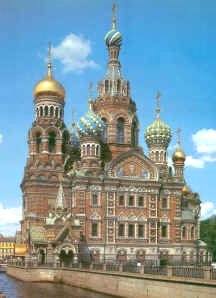 Cathedral of the Resurrection of Christ
TTHE MARIISKY THEATRE
The history of Mariinsky (Kirov) theatre begins with the Grand theatre of St. Petersburg built in 1783. Since the beginning of the 19th century the St. Petersburg ballet group has been known as the finest example of Russian classical ballet school. Mariinsky theatre’s stage has presented innumerable world-famous pieces of Russian opera: several major works by Glinka, Borodin, Rimsky-Korsakov and Mussorgsky were performed here for the first time. Tchaikovskiy’s ballets and operas were also staged at the Mariinsky theatre. World-known dancers of our century, such as Galina Ulanova, Rudolf Nureyev, Natalia Makarova and Mikhail Baryshnikov started their remarkable careers in this theatre. Today the conductor Valery Gerbiev who directs the opera, the orchestra and the ballet leads Mariinsky theatre.
THE HERMITAGE
The State Hermitage occupies six magnificent buildings situated along the embankment of the River Neva, right in the heart of St Petersburg. The leading role in this unique architectural ensemble is played by the Winter Palace, the residence of the Russian tsars that was built to the design of Francesco Bartolomeo Rastrelli in 1754-62. This ensemble, formed in the 18th and 19th centuries, is extended by the eastern wing of the General Staff building, the Menshikov Palace and the recently constructed Repository.
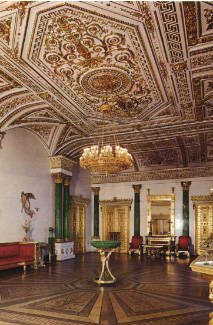 The State HermitagePut together throughout two centuries and a half, the Hermitage collections of works of art (over 3,000,000 items) present the development of the world culture and art from the Stone Age to the 20th century. Today the Museum is creating its digital self-portrait to be displayed around the world. Computer technologies enable the State Hermitage Museum to provide people from all over the world with wider access to information about the Museum and its treasures.
THE WINTER PALACE
The Winter Palace is undoubtedly the most famous building of imperial St. Petersburg, not only as the residence of the Tsars and the backdrop for the 1905 and 1917 Revolutions, but also as the home of the Hermitage, the world's largest museum of art.
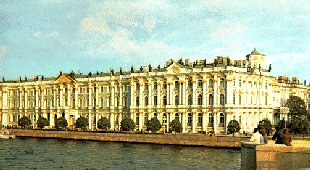 The Winter Palace
The present structure, completed in 1762 and designed by Bartolomeo Rastrelli, was commissioned by the Empress Elizabeth. Its opulent baroque facade, stretching two hundred meters, is a veritable cornucopia of pilasters, bays, and statuary. The palace served as the winter residence for every ruler of Russia since Peter III, who installed himself there along with his mistress, the Countess Vorontsova. After his wife Catherine the Great seized the throne, she redecorated and appropriated her husband's old quarters. While her son Nicholas I lived in a modest apartment there, his wife Alexandra commissioned the famously luxurious Malachite Room, later to be used as the meeting place for Kerensky's Provisional Government. Nicholas II had his quarters immediately above this room until 1904, when he moved from the increasingly discontented capital to Tsarskoe Selo. In July of 1917, the Provisional Government took up residence here, thus setting the stage for the October Revolution. After consolidating its power, the Bolshevik government transferred its capital to Moscow, and since that time the Winter Palace has been associated primarily with its role as the Hermitage Museum.
THE RUSSIAN MUSEUM
Like the Tretyakov Gallery in Moscow, the Russian Museum contains one of the finest collections of Russian art in the world. Both museums provide outstanding coverage of the entire history of Russian art. However, while the Tretyakov knows no peers for its collection of icons, the Russian Museum's international supremacy is based on its extensive collection of late 19th and early 20th century Russian works. One of the best characteristics of the Russian Museum is that it is organized in a clear chronological progression, thus providing a very good picture of the major developments in the history of Russian art. Of particular interest are the ground floor, which covers the nineteenth century, and the Benois wing, which contains the museum's unparalleled collection of twentieth century works. Although most of the avant-garde works of the Benois wing were held in storage after the official embrace of Soviet realism in the thirties, they have slowly been emerging in recent years.
PETER AND PAUL FORTRESS
The Peter and Paul Fortressis historical core of St.Petersburg. It is a monument of military and engineering craft. It was laid by the order and to the plot-plan of Peter the Great on May 16 (27) 1703 on Zayachy Island that is linked with Petrogradsky Island by Ioanovsky and Kronverksky bridges.
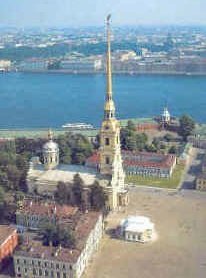 Peter and Paul FortressThe Fortress forms an irregular hexagon stretched from West to East with 6 bastions at the corners. The fortress was constructed "in quite a haste" under supervision of Peter the Great and his closest associates. In 1706-40 the walls of fortress that face the Neva River were lined with granite blocks. For defense of the northern approaches to the Peter and Paul Fortress the Kronverk fortifications were constructed on the southern bank of the Petrogradsky Island. A canal was dug in the territory of the fortress to bring construction materials and supply the garrison with water. It was filled up with ground in 1882. The parade Petrovsky gate is located in the Eastern Wall of the fortress. Vasiliev gate is in the Western Wall, Kronverk and Nicholas gates are in the Northern Wall, and Neva gate (leading to the jetty) is in the Southern Wall. Ioannovsky Ravelin was constructed in 1731-40 outside the fortress on the eastern side, while 1733-40 Alexeyevsky Ravelin was built on the western side.
The new Peter and Paul Cathedral of stone appeared in 1712-33 in place of the old wooden church of St. Peter and St. Paul. The cathedral became the burial-vault of Russian Emperors.
PALACE SQUARE
Designed as the successor to Moscow's great imperial squares, this vast formal court is best known as the focal point of the great political struggles that transformed Russia in the first decades of the twentieth century.
The Palace Square is the most grandiose among the squares of the city. The facade of the Winter Palace forms its northern border. The semi-circular facade of the General Stuff and Ministries Building is its southern border. The General Stuff Building is a genius creation of the architect K.Rossi. The building of the Guard Stuff closes the Square from the eastern side.
The Alexander Column was erected in the center of the Square to commemorate the victory over Napoleon in the war of 1812, and to honor Emperor Alexander I. The building of Admiralty faces the western border of the Palace Square. The facade of the Admiralty and the Alexander Garden that is in front of it, link the Palace Square to the Decembrist Square (the Senate Square).
THE ADMIRALTY
The Admiralty building was constructed in 1823 as the administrative headquarters of the Russian Navy. Designed by Andreyan Zakharov, it is a foremost example of the Russian Empire style of Classical Architecture with its rows of white columns and statuary.
 The Admiralty
NEVSKY PROSPECT
The Nevsky Prospekt is the main thoroughfare of St.Petersburg that starts from the Admiralty Prospekt and ends at the Alexander Nevsky Square. It is 4.5 km long and 25 - 60 meter wide. The part between the Square of Insurrection and the Alexander Nevsky Square is traditionally called Old Nevsky Prospekt. The Moyka River (the Narodny Bridge), the Fontanka River (the Anichkov Bridge), and the Griboedova Canal (the Kazansky Bridge) cross Nevsky Prospekt.
The Nevsky Prospekt appeared in 1710 as two roads in boggy forest leading from the Admiralty and from the Alexander Nevsky Monastery to the Old Novgorod high road. The part from the Admiralty to the present Square of Insurrection was known as a Big Prospect which was the main entrance to the city. In the thirties of the 18th century the road was called the Neva Prospect. In the sixties of the 18th a singe thoroughfare was formed which from the end of the 18th century acquired the present name of Nevsky Prospekt.
ST. ISAAC'S CATHEDRAL
The weighty mass of St. Isaac's Cathedral dominates the skyline of St. Petersburg. Its gilded dome, covered with 100 kg of pure gold, soars over 100 meters into the air, making it visible far out onto the Gulf of Finland. The Cathedral was commissioned by Alexander I in 1818 and took more than three decades to complete.
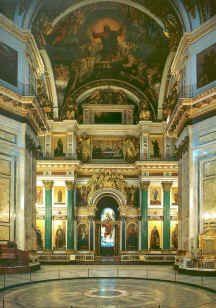 St. Isaac's CathedralIts architect, August Monferrand, pulled out all the stops in his design, incorporating dozens of kinds of stone and marble into the enormous structure and lading its vast interior with frescoes, mosaics, bas-reliefs, and the only stained glass window in the Orthodoxy. By the time the cathedral was completed in 1858, its cost had spiraled to more than twenty million rubles--as well as the lives of hundreds of laborers. Both the exterior and the interior of the cathedral deserve prolonged observation, and the view from the dome is stupendous.
THE KAZAN CATHEDRAL
Kazan Cathedral is one of the grandest churches in the city. The Cathedral was built to house the venerated icon, Our Lady of Kazan, and was named after it. The Cathedral was constructed on the Order of the Russian Emperor Paul I, being modeled on St. Peter’s in the Vatican (arch. A.Voronikhin). It is a monument, commemorating the Russian victory over France in the Russo-Napoleonic War of 1812-1814. The Cathedral became the burial place of the Field-Marshal Kutuzov, who was at the head of the Russian Army during the War, the character of Tolstoy’s novel "War and Peace". It was also here that the numerous trophies were brought including keys of European cities surrendered to the Russian Army. During the Soviet period the cathedral housed the Museum of History of Religions and Atheism. At the present time the museum’s display is dedicated to the history of Orthodox Religion in Russia, the history of Western Christianity and religious art. It possesses an enormous collection of cult objects and paintings.
MENSHIKOV PALACE
The palace of the first Governor of St. Petersburg, built in the early XVIII century was the first stone building in St. Petersburg (architects G. Fontana and I. Schedel), first residential structure on Vasilievsky Island and the finest one in the city, surpassing even Peter’s Summer Palace. The Tsar had no objections, preferring to entertain at Menshikov’s Palace, which was furnished to suit his tastes. In the building, the fragments of the original interiors of the XVIII century has been preserved, among them the famous Dutch tiles. Exhibition of the State Hermitage Museum, dedicated to Russian culture of Peter’s time open to the public.
DECEMBRISTS SQUARE
The second of St. Petersburg's great squares is named for the unsuccessful Decembrists' revolt on December 14, 1825. The rebels were attacked, captured, and later executed or exiled in Siberia.
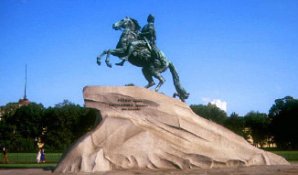 The Bronze HorsemanPeter the Great Statue (The Bronze Horseman) stands at the river end of the square. The monument was commissioned by Catherine the Great and sculpted by the Frenchman Etienne Falconet. This striking statue has long been one of the most symbolic monuments in St. Petersburg. In 1833 Pushkin immortalized it in his masterful poem The Bronze Horseman, in which the statue comes to life to pursue the poor clerk Yevgeny through the flooded streets of the city.
THE AURORA CRUISER
It was founded in 1897 and launched in 1900. It is named after the Aurora frigate that defended Petropavlovsk on Kamchatka during the War of 1853-56. The cruiser participated in the Tsusima battle. From November 17 1948 the cruiser became the monument of the October revolution. It is located near Petrogradskaya Embankment of the Bolshaya Nevka River. Form 1957 it is an affiliate of the Navy museum.
ENGINEER’S CASTLE
Paul I began the heavily fortified castles shortly after he assumed the throne, in an attempt to allay his fear of being assassinated. In January 1801 the imperial family moved onto it. On the night of March 12, 1801, only 40 days after he had moved in, Paul I was assassinated in his bedroom by conspirators. In 1819 the building was handed over to the School of Military Engineers, hence the name. F. Dostoevsky, famous Russian writer, graduated from the School as a fortification engineer. Since the Revolution, it has been used to house various libraries and record officers and most recently the restorers’ workshops of the State Russian Museum. In 1991 it was transferred into the complete possession of the Museum. At present it houses the collection of the Romanov Portrait Gallery in some restored halls.
ACADEMY OF FINE ARTS
The building is one of the most outstanding samples of Rusian 18th century architecture designed by A.Kokorinov and Vallin de la Mothe (1764-1788). The names of many outstanding Russian artists are associated with the Academy of Fine Arts that was established in 1754. It boasts an impressive roll call of graduates, including architects Zakharov and Voronikhin, sculptor Pyotr Klodt, painters Karl Bryullov and Ilya Repin. The last has given his name to the Institute of Painting, Sculpture and Architecture that now occupies the building, whose museum displays graduates’ works collected over the years and replicas of masterpieces painted as teaching aids in the early 19th century.
MARBLE PALACE
The architect A. Rinaldi in the second half of the 18th century and its outward appearance has remained almost unchanged ever since designed the splendid Marble Palace. Both the interior and exterior are fronted in 32 different kinds of marble, hence the name. Catherine the Great ordered the Marble Palace to be built as a present for her lover, Count Orlov. After his death in 1783 the palace was acquired into the Treasury. It used to be the residence of S.Poniatovsky, the last king of Rech Pospolita. Later, up to 1917, it was owned by several Grand Dukes in succession.
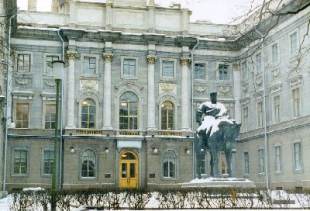 The Marble Palace
By the mid-nineteenth century, the palace was in ruins, only restored and refurbished by its owner, Grand Duke Constantine Nickolaevich, a poet and playwright. His translation of Shakspeare’s Hamlet was considered to be the best one at the time. He was the author of the tragedy "Czar Judaic". Some interiors, in the southern wing of the palace, where he lived with his family, have been restored and open for public. Formerly home to the Leningrad branch of the Central Lenin Museum, it is now used for a subsidiary art gallery for the Russian Museum, which puts on temporary and permanent exhibitions entitled "The twilight zone between oblivion & remembrance", " Foreign artists in Russia" (VIII- XIX cent.) and "Peter Ludvig Museum in the Russian Museum ".
|
|
|
Holidays & Events
New Year's Day, January 1
The last week in December is quite festive, culminating with New Year's Eve. Presents are given on New Year's Day.
Russian Orthodox Christmas,
January 7
A new official holiday celebrates Russian Orthodox Christmas.
(The Orthodox Church still follows the old calendar, which differs from the Gregorian by 13 days.) Churches throughout the country hold services.
Women's Day, March 8
Established after the Second International Conference of Socialist Women in Copenhagen in 1910, women receive gills and usually do not have to work'. Even though socialism is out, celebrating women is still in!
Easter or Pashka, March/April
Traditional Russian Orthodox holiday
May Day, May 1
Even though no longer celebrated as International Workers' Solidarity Day, this event, now known as Labor and Spring Holiday, retains the festive nature, with colorful parades through Moscow's Red Square and St Petersburg's Palace Square.
Victory Day, May 9
Parades are held at war memorials such as the Piskaryovskoye Cemetery in St Petersburg to celebrate V-E Day at the end of World War II in Europe.
Maslenitsa, or Blini Day, 1st week in March
This day stems from the Pagan tradition of making blini pancakes to honor the coming of spring; blini represent the sun.
Each spring, there are festivals in the major cities and towns to celebrate the end of winter.
Navy Day, July
In St Petersburg, the fleet, including ships, submarines and sailors, is displayed about the city.
White Nights Festival, June 21 to July 11
While the sun hardly sets, many musical concerts, theatrical performances, street events, fireworks and other celebrations take place throughout Moscow, St Petersburg and the Golden Ring area.
Siege of Leningrad Day, September 8
This day marks the end of the 900-day seige of former Leningrad and includes special ceremonies at the Piskarovskoye Cemetery.
Moscow Day, Sept 19
A day for merry-making in the city.
Anniversary of the October Revolution,
November 7
A traditional holiday for nearly 75 years to commemorate the Anniversary of the October Revolution
(on the old calendar, the revolution took place on Oct 25). No longer a state holiday, many Russians continue to celebrate not having to celebrate the 1917 Revolution anymore!
Russian Winter Festival,
December 25-January 5
Events are held to celebrate the coming new year, especially in Moscow, St Petersburg, Novgorod, Vladimir and Suzdal, where troika rides, along with other traditional Russian folk customs, take place. Because the Soviet Union ceased to exist on December 21, 1991, Christmas week now offers another reason to celebrate a new beginning.
|